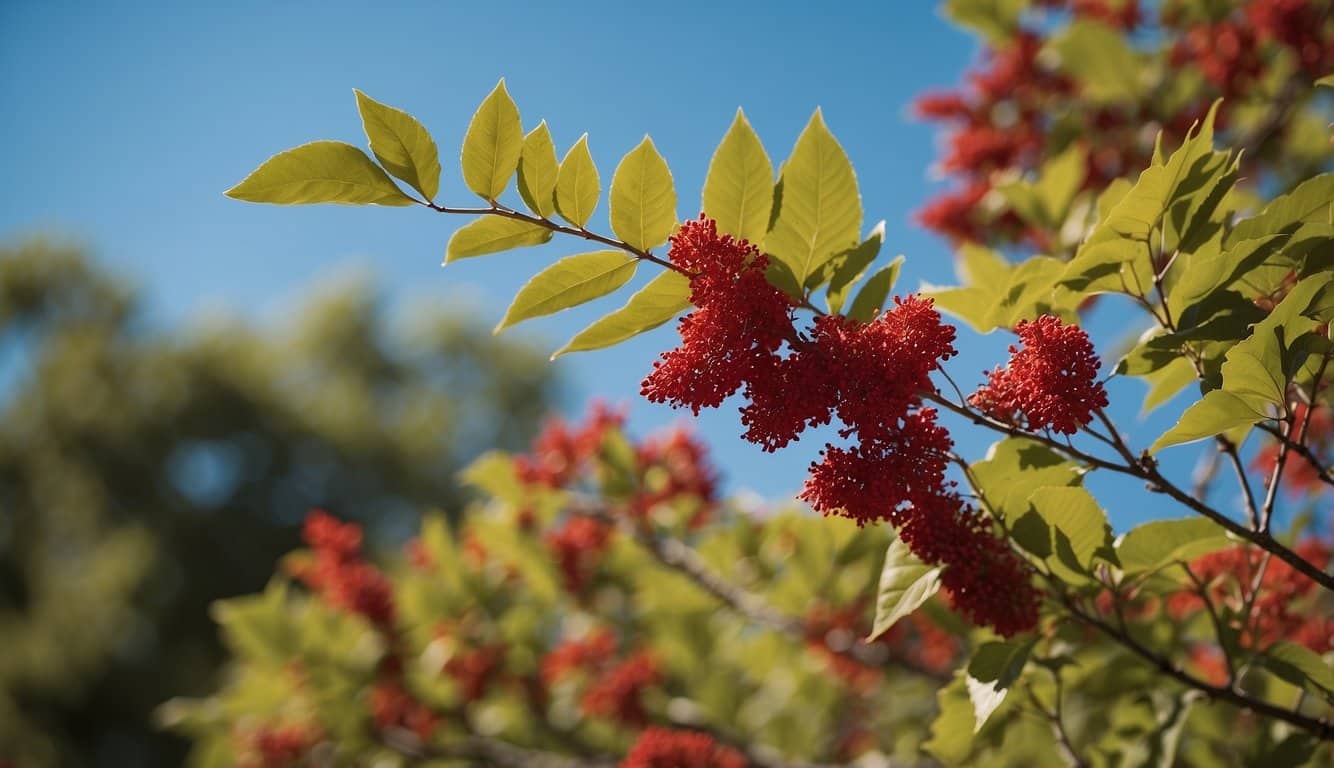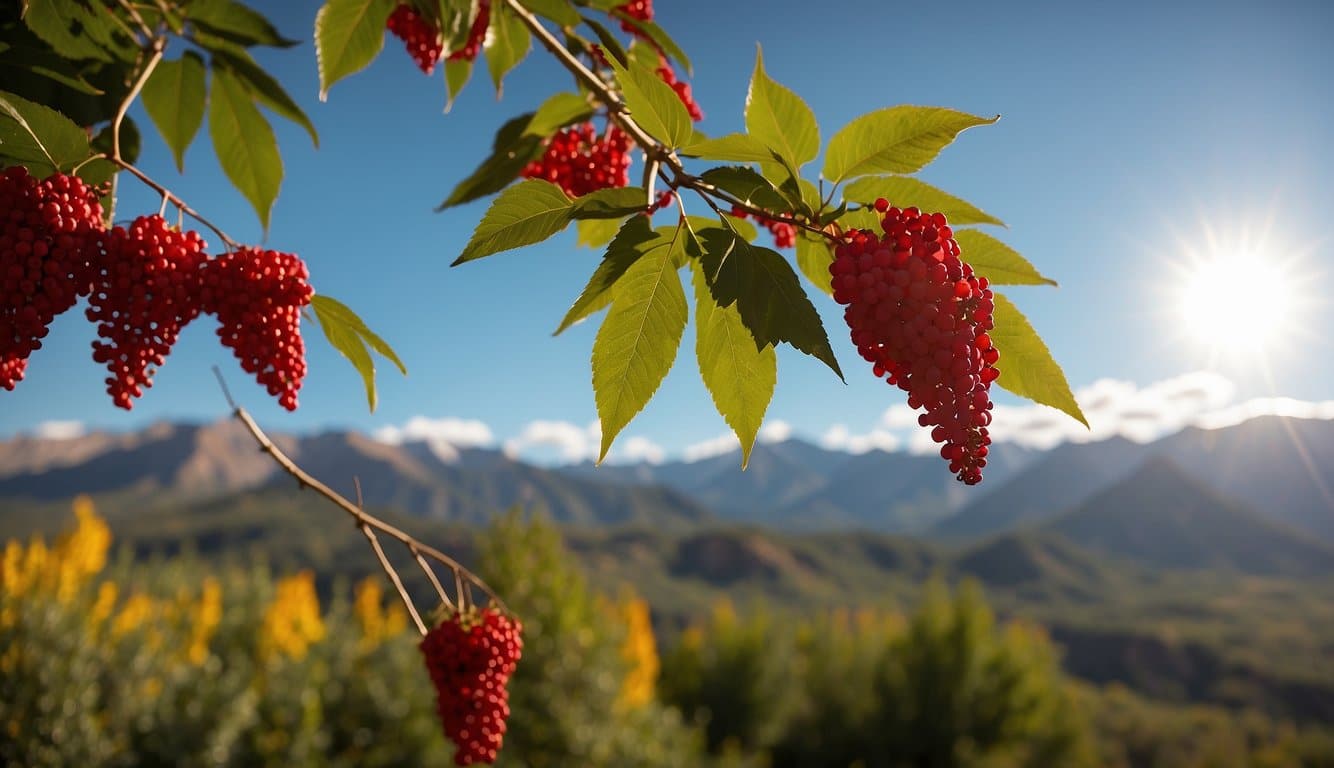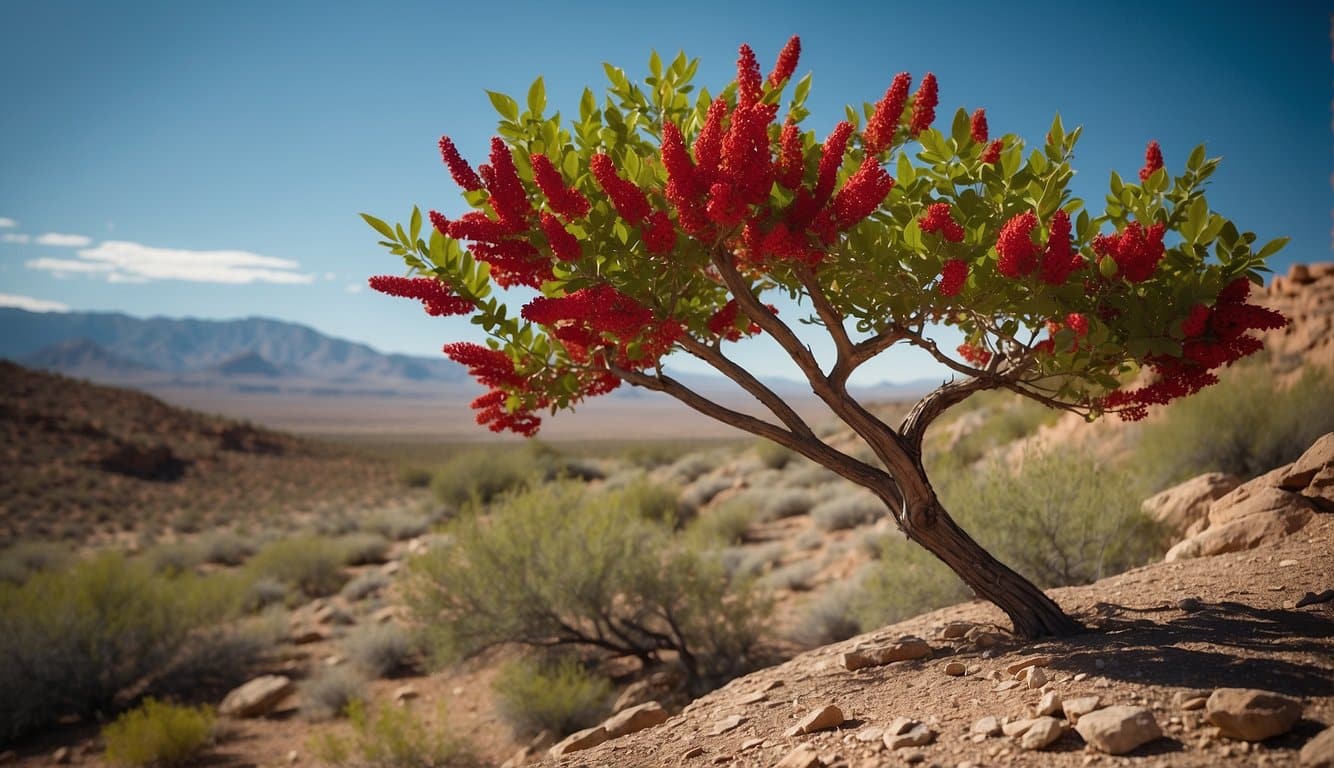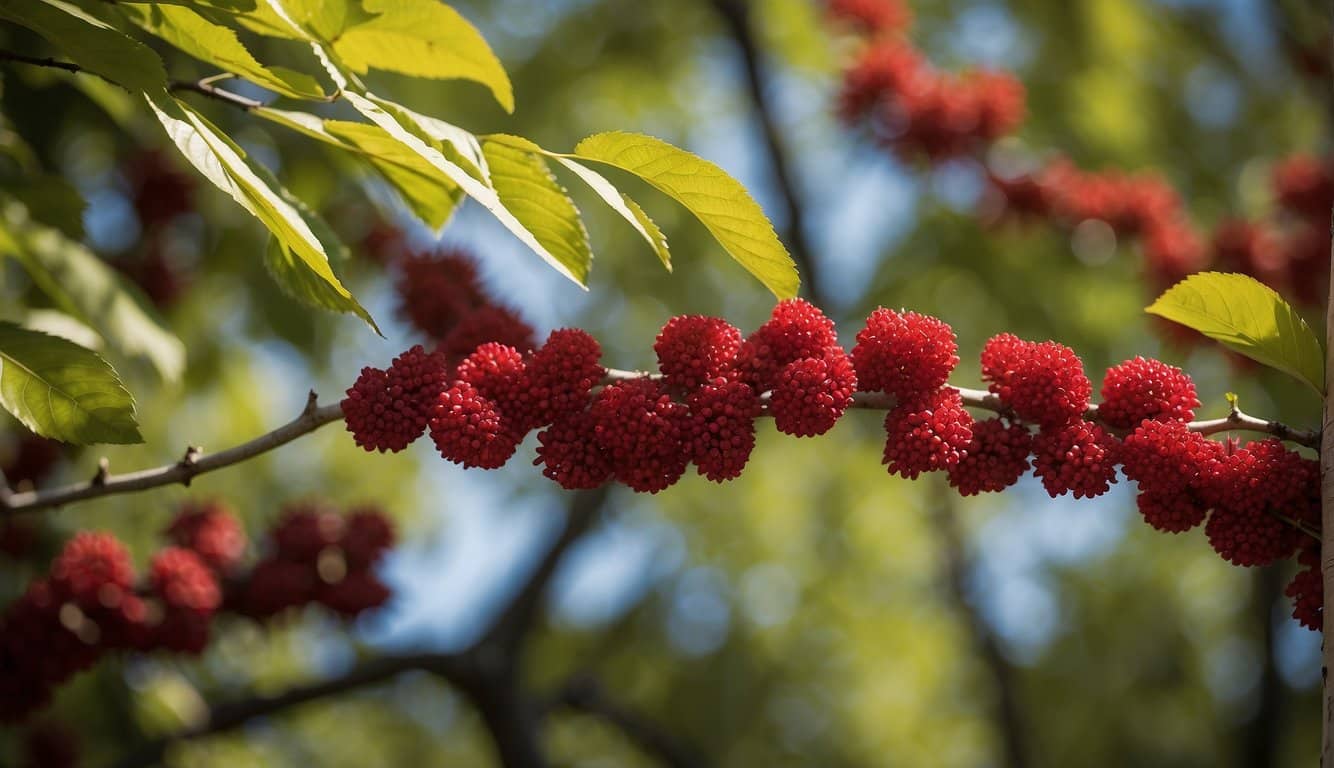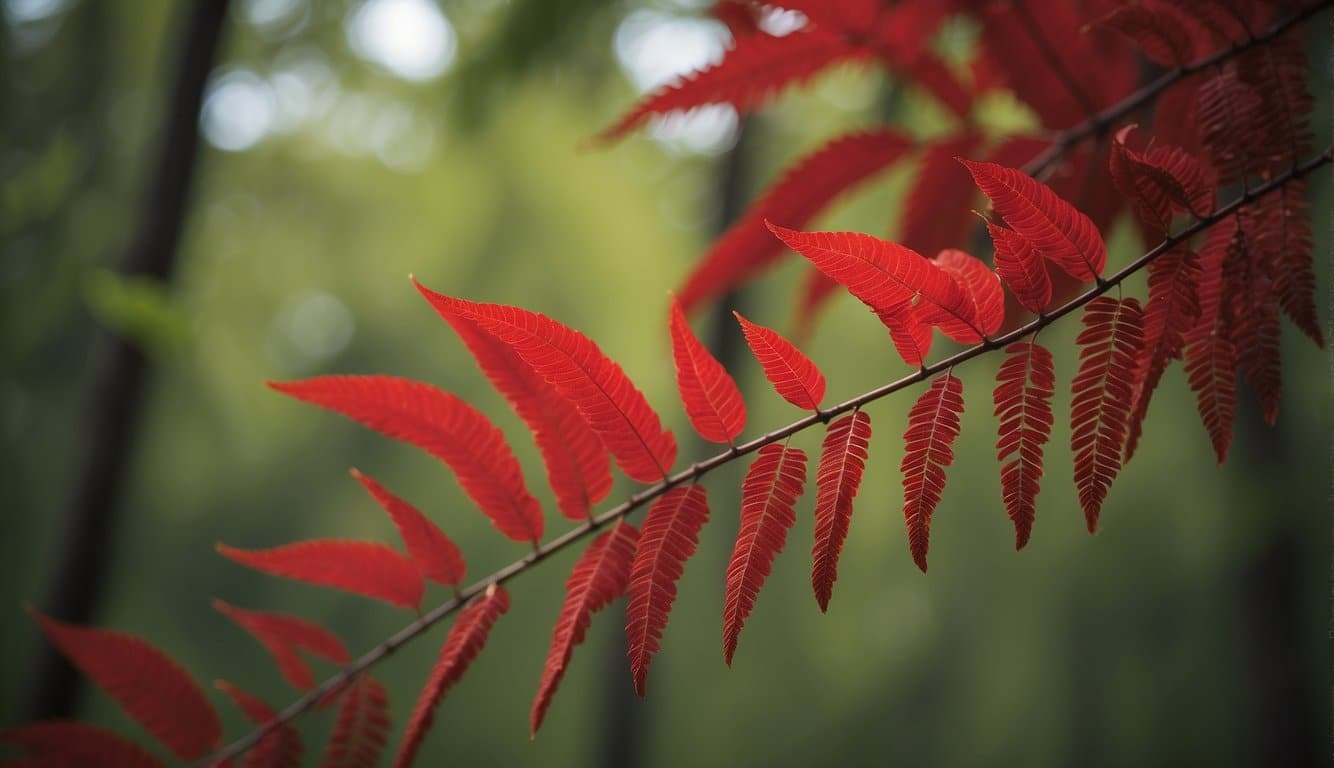The Colorado sumac tree, recognized for its vibrant autumnal foliage and robust presence across various landscapes, is a sight to behold in the wild expanses of Colorado.
Referenced often in ecological discussions and landscaping projects, this hardy shrub is not just an aesthetic addition but an essential player in its native habitats.
With an ability to thrive in a variety of soil conditions and its easy-to-identify features such as the fern-like pinnate leaves and distinctive red berries, the Colorado sumac is as practical as it is picturesque.
In identifying a Colorado sumac, one must look for the tree or shrub’s standout features which directly contribute to its popularity in both natural and cultivated settings.
Its growth characteristics, including its moderate size and the conical clusters of flowers, play a significant role in its identification.
These characteristics also highlight the adaptability and ecological impact of the Colorado sumac, as it provides food for wildlife and contributes to the biodiversity of the region.
Key Takeaways
- Colorado sumac is a versatile and ecologically significant shrub in Colorado.
- Identification features include pinnate leaves and red berries.
- Questions often pertain to its edibility and role in landscaping and ecology.
Identification of the Colorado Sumac Tree
One can recognize the Colorado Sumac, often referred to as Three Leaf Sumac, by its distinctive features.
It has a growth form that classifies it as a broadleaf deciduous shrub, which radiates a rustic charm with its hardy nature and vibrant hues, particularly when its yellow to orange-red foliage announces the arrival of fall.
- Leaves: Colorado Sumac bears compound leaves that typically house three stalkless leaflets. Each leaflet is elliptic to obovate, spanning 1.5-2.5 cm in length with a wedge-shaped base. Notably, the terminal leaflet may display a tri-lobed appearance.
- Berries: This species is also celebrated for its tart, edible red berries, which are a delight to local wildlife and can be used in making sumac lemonade.
- Size: The Colorado Sumac maintains a modest stature, growing to over 6 feet tall, fitting seamlessly into both natural landscapes and cultivated garden arrangements.
The plant’s adaptability is also noteworthy, as it thrives in the diverse Colorado climate as well as similar USDA hardiness zones ranging from 3 through 9.
Its resilience allows it to prosper in various soil conditions, though it is often found in drier, less nutrient-rich soils.
When hiking through the Rocky Mountains or exploring the varied terrain of Colorado, the Three Leaf Sumac stands out with its natural elegance.
Gardeners hold it in high esteem for the low maintenance and year-round interest it contributes to any landscape design.
Habitat and Distribution
Sumac trees are resilient and adaptive plants that thrive in various environments across Colorado. They are an integral part of the state’s natural flora, offering substantial ecological benefits.
Geographic Range
Colorado’s sumac species, particularly the Three Leaf Sumac (Rhus trilobata), flourish predominantly within the state’s diverse regions. They are not confined to a single area but spread throughout a wider range, extending beyond the state lines.
- Northern Colorado: Found in sparse woodlands and grasslands.
- Eastern Slopes: Adapted to the foothills and montane zones.
- Southern Plateaus: Common in semiarid plateaus and mesa regions.
Preferred Environments
Sumacs in Colorado are known for their hardiness and preference for specific types of environments.
- Soil Conditions: Favor well-drained soils, tolerating both sandy and loamy substrates.
- Sunlight: Require full sun to partial shade, thriving in open spaces.
- Moisture Levels: Can withstand periods of drought, indicative of their adaptability to semi-arid climates.
These trees often contribute to ecosystem stability by creating habitats for various wildlife species, highlighting their ecological importance in Colorado’s landscapes.
Growth and Physical Characteristics
Colorado’s sumac trees are notable for their vibrant seasonal foliage and hardy growth habits. This section will explore their distinctive leaves and rugged bark, the appearance of their flowers and fruits, and their overall height and form which suit the varied landscapes of Colorado.
Leaves and Bark
Leaves: The leaves of the Colorado sumac species, such as the Three Leaf Sumac, are typically alternate and compound with three leaflets that are elliptic to obovate and measure 1.5-2.5 cm long.
The Staghorn Sumac features larger pinnately compound leaves that can grow 12-24 inches long with numerous leaflets. Most types of sumacs have leaves that exhibit vibrant yellow to orange-red hues in the fall.
Bark: The bark of sumac trees like the Staghorn Sumac is recognized by its very hairy texture, particularly on new growth.
Flowers and Fruits
Flowers: Sumac trees produce flowers that may vary from species to species.
For example, the Smooth Sumac blooms in the spring or early summer with yellowish-green flowers that form in upright cone-shaped panicles.
Fruits: The edible red berries of the Three Leaf Sumac are a stand-out feature, growing in clusters and presenting a tart flavor.
Height and Shape
Height: The typical sumac can vary considerably in size, with species like the Staghorn Sumac growing up to 20 feet tall, while others remain shrub-sized.
Shape: Sumacs often exhibit a suckering growth habit, meaning they can grow as multi-stemmed shrubs. This adaptability allows them to thrive in various conditions and can contribute to the appearance of dense thickets if suckers are not removed.
Ecological Impact and Conservation
In Colorado, sumac trees are recognized not only for their vibrant autumn foliage but also for their role in local biodiversity and the need for thoughtful conservation practices.
Role in the Ecosystem
Sumac trees contribute significantly to the ecosystems where they thrive.
They provide essential food sources through their berries, which persist into winter and offer nourishment for birds and other wildlife when other food is scarce.
The dense growth habit of species like the Fragrant Sumac makes these shrubs excellent for stabilizing banks and slopes, thus preventing soil erosion.
Additionally, sumacs are involved in complex ecological relationships, supporting pollinators and acting as host plants for various insect species.
Conservation Status
While sumacs like the Smooth Sumac and Fragrant Sumac appear to be abundant, they face threats from habitat alteration and consumption of their wood for fuel and fencing.
Conservation efforts are essential to maintain their populations and the ecological services they provide.
Efforts include managing tree cover to support biodiversity, preserving natural hydrology that sustains sumac growth, and protecting sumac thickets from overharvesting.
Conservationists emphasize the importance of sumac trees in maintaining soil health and supporting higher levels of local biodiversity.
Frequently Asked Questions
This section is dedicated to addressing some of the most common inquiries about sumac trees in Colorado, covering their unique characteristics, identification of edible kinds, growth patterns, challenges, differentiation from poisonous relatives, and environmental contributions.
What are the distinguishing features of Staghorn Sumac in Colorado?
Staghorn Sumac is noted for its striking open branching that resembles deer antlers and can reach a height of 15 to 20 feet.
The species is recognized for its long, hairy, red fruit clusters and low-water cultural requirements.
What should I look for when identifying edible sumac varieties?
Edible sumac varieties, such as Staghorn and Smooth Sumac, can be identified by their red berries and serrated leaf edges.
It’s important to look for the dense clusters of fuzzy red fruits, which are typical of these species.
Can you explain the typical growth rate of sumac trees in Colorado?
Sumac trees in Colorado generally exhibit a moderate growth rate.
These shrubs or small trees may vary in size from three feet up to twenty feet tall, depending upon the species and the environmental conditions.
What are the common issues encountered with sumac trees in Colorado?
Sumac trees in Colorado are sometimes prone to spreading aggressively through suckers if not properly managed.
They may also encounter issues related to overwatering, given their preference for drier conditions.
How can one effectively differentiate between poison sumac and other sumac species?
Poison sumac can be distinguished from other sumac species by its white berries, which hang in loose clusters, as opposed to the red, dense clusters found on non-poisonous varieties.
Additionally, poison sumac tends to grow in wetter environments.
In what ways are sumac trees beneficial to the ecosystem or garden?
Sumac trees offer significant benefits to ecosystems and gardens.
These benefits include autumn coloration enhancement and wildlife support through their berries. The berries serve as a food source for birds and small mammals. They also aid in soil stabilization with their robust root systems.
